There are chocolate glazes, and then there are CHOCOLATE glazes. Some look so luxurious and chocolatey they may precipitate drooling, but, then, sadly, fail to deliver: When you take a taste and try to savor the expected big burst of flavor, no matter how you try, it’s … just … barely … detectable. Where, oh where, is the chocolate?
A good chocolate glaze–like the one on this cake– on the other hand, is immensely, immediately gratifying. It reassures you that all is right with the world. The chocolatiness blooms in the mouth, flooding the senses with a deep, dark chocolate flavor and aroma and seducing the tongue with a satiny smoothness. It’s instantly obvious why the Aztecs (and everybody since then) called chocolate the food of the gods.
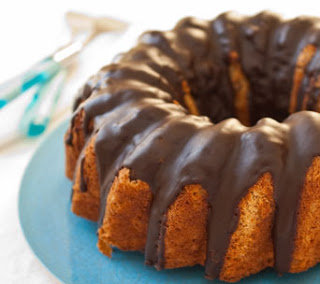
Although making a tempting chocolate glaze might seem like a simple task (and certainly can be with the following recipe), coming up with good all-purpose version is not simple. I discovered this back in the 1980s while creating recipes for my International Chocolate Cookbook. It literally took so many dozens of tries to produce just a couple of passable glazes that several of my tasters got bored sampling!
The reason for all the recipe fussing and fiddling is that chocolate is chemically complex and cranky. Add just a splash too little liquid, and it can turn to stone. Apply a little too much heat, and it will taste weird, in the worst case, like burnt rubber. Fail to stir it at the right moment, and it will be splotchy on top.
Also, chocolate is sold in a wide array of formulations, from milk chocolate and semisweet, to bittersweet and unsweetened and they are NOT interchangeable. Each recipe has to be designed to accommodate the properties of the specific chocolate product featured.
This very straightforward recipe is adapted from one I devised for the chocolate book. I recently updated it to take advantage of the microwave oven and readily available chocolate from the supermarket. I also wanted it to be dead easy, quick, and foolproof. But note that to get the reliable results you must resist the urge to substitute for, omit, or add ingredients. And you must carefully follow the simple preparations steps.
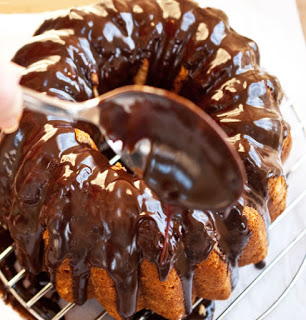
Here are a few dos and don’ts, plus the whys behind them:
First, use good quality regular semisweet chocolate morsels only; the readily available Nestle semisweet chips or a comparable brand with a taste you like will do nicely. The chi-chi gourmet bittersweet chips you might be tempted to substitute will not only produce a glaze that’s too bitter and overpowering for many baked goods, but can cause a glaze to turn pasty, dry, oily and dull as it sets. (If you absolutely must have a slightly less sweet glaze, use 3/4 cup semisweet chips, and 1/4 cup bittersweet morsels.)
Why the texture problems anyway? Because the bittersweet morsels contain a higher percentage of cacao than semisweet–usually 60 percent or more. Which means they have a higher fat content due to the extra natural chocolate fat, cocoa butter, as well as more thickening and drying power due to their higher percentage of natural chocolate starch. Bottom line: In this recipe substituting bittersweet morsels may result in a greasy, yet simultaneously dry and crumbly glaze.
Second, don’t sully the chocolate flavor with a lot of add-ins. The unsalted butter enhances, but don’t be tempted to replace the water with cream, as it can mask some of the brightest, clearest flavor notes. And do use unsalted butter; salted will make the glaze taste noticeably salty.
Third, don’t omit the corn syrup. This product helps keep the glaze smooth and gives it that glorious high gloss; even after it stands several days (see the pic at the very top) it will still have a pleasing satiny sheen. If you are concerned and wish to avoid high fructose corn syrup, choose the Karo brand, which contains no high-fructose syrup.
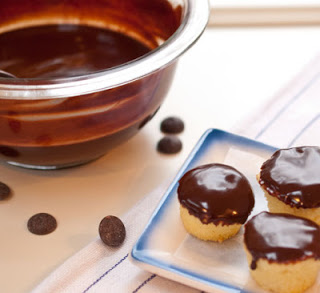
Fourth, don’t try to thicken or sweeten the glaze with powdered sugar. Besides over-sweetening, the sugar (which also contains cornstarch) will act as a filler and dilute the chocolate flavor. If after tasting, you want a slightly sweeter glaze, stir in up to 2 tablespoons of honey.
Additionally, powdered sugar is never needed to thicken: If you allow the glaze to stand and cool as directed, its natural chocolate starch will gradually stiffen the mixture so it has sufficient body for drizzling or dipping. The natural chocolate starch will further firm up the glaze over time.
Good & Easy Chocolate Satin Glaze
Taste, looks, ease, and versatility are the reasons I turn to this recipe when I want to dress up or add a chocolate dimension to baked goods. As you can see from the photos, the glaze is ideal for drizzling over a Bundt cake, or for dipping cupcakes or even cookies. It is also a perfect topper for an 8- or 9-inch pan of brownies.
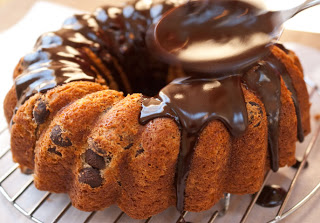
The cake shown, a sumptuous banana-chocolate chip Bundt, is here. My classic brownie recipe is here.
1/2 stick unsalted butter (4 tablespoons), cut into chunks
1/4 cup warm water, plus more if needed
1 cup semisweet chocolate morsels (not milk chocolate or bittersweet morsels)
1 teaspoon light or dark corn syrup
1 teaspoon vanilla extract
1 to 2 tablespoons clover honey (or other mild honey), optional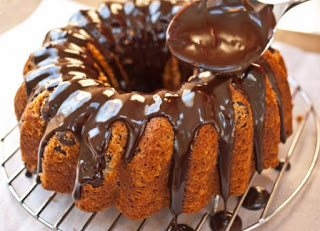
minute. Stop and stir briefly. If the butter is not completely melted,
microwave 20 seconds longer, then stir until the butter melts completely.
Lightly stir in the chocolate
morsels. Microwave 20 seconds longer. Stir or whisk the glaze until completely
smooth.
Thoroughly stir the corn syrup and vanilla into the mixture. If the glaze is stiff and oily-looking, gradually thin it with 1 to 1 1/2 teaspoon warm water. If you want a sweeter glaze, stir in the honey to taste.
Set the glaze aside to cool and thicken, stirring occasionally for about 20 minutes; or, if you are in a hurry,
place it in the refrigerator, stirring every few minutes. It needs to cool and stand until it has some body and will slowly flow, but be thick enough not
to run. If convenient, the glaze can be made ahead and refrigerated, airtight, for up to a week. Then warm it just until fluid again using the microwave oven set to 50 percent power. Microwave for 20 seconds, then stir well; repeat as necessary.
If drizzling the glaze over a cake, set it on a rack over paper. Spoon the glaze over top as shown, allowing it to flow attractively
down the sides. Let stand a few minutes, then with wide spatulas, transfer the cake to a decorative plate. Store covered with a cake cover.
If dipping cupcakes, carefully brush off any loose crumbs first. If dipping cookies, transfer the glaze to a small, deep bowl to increase the depth of the pool. Dip the cookies in until half of the top surfaces are coated vertically, then remove the excess glaze from their undersides by scraping against the bowl sides. Let the cupcakes or cookies stand until the glaze sets about 30 minutes before packing airtight in a single layer.
Hungry for another tempting, foolproof chocolate recipe; my thoroughly tested, (and delish) rocky road fudge is here.
If you’re interested in a non-chocolate sweet treat for a Valentine, check out these very pretty (and tasty) heart cookies. They are dye-free and easier to make than you might think. 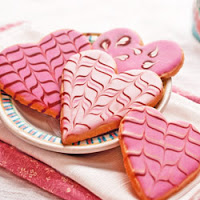

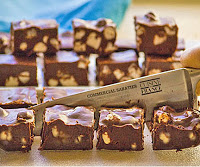

I was wondering what to take to a brunch this weekend. Perfect! I even have corn syrup in the house. And I only use unsalted butter, so I'm on my way.
Rebecca, thanks for trying again. I don't know what the problem could be…. Just love technology….
Just tried leaving a comment, and blogger dumped me somewhere else. Trying again. Love your easy glaze tips.
Stacy, thanks–glad to know I didn't bore you with all the chemistry. Chocolate is tricky and if peeps try to change the ingredients or method things can go really wrong. I thought I should explain why it was important not to take liberties with the recipe.
Elizabeth, I call for unsalted butter because I find the glaze will taste salty if I use salted butter. You could try it–if you like your food salty you might not notice….
Nancy, your recipe for a satiny chocolate glaze, ROCKS! Thank you for explaining all the food science. Everything made total sense!
Oh,yum! Chocolate is my thing, and this looks perfect. Gotta rustle up some ingredients. I'll try this tomorrow for my DH. Thanks!
Wow, that just looks soooooo yummy. Why does the butter need to be unsalted? Asking because I don't usually have unsalted butter in the house. Just curious if it would change the recipe all that much.